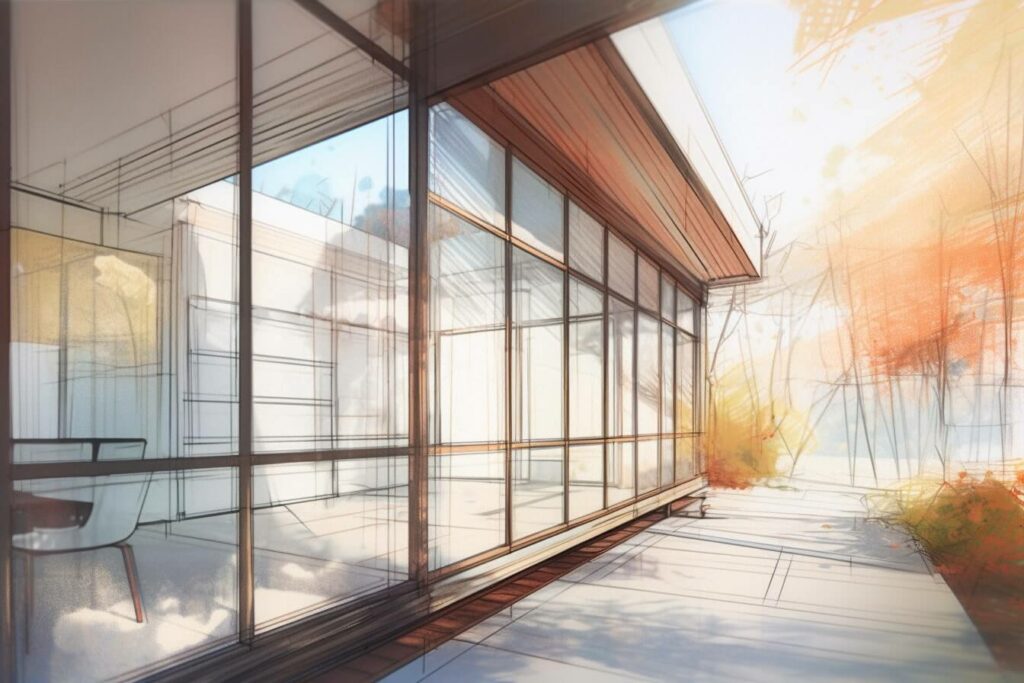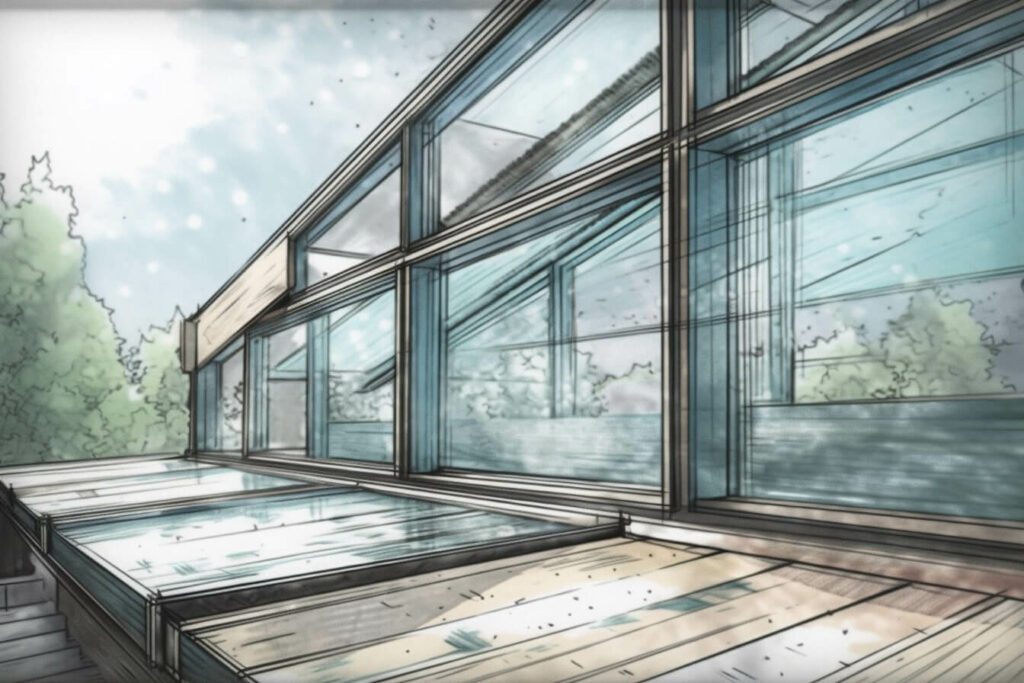




A 2-day immersion into the future of sustainable construction
As architects and interior designers increasingly embrace sustainable design principles, glazing insulation has emerged as an innovative and eco-friendly solution for modern construction projects. This comprehensive guide delves into the remarkable benefits of glass insulation in construction and addresses the most commonly asked questions about this cutting-edge material.
By the end of this article, you will be eager to explore the possibilities of incorporating glazing insulation into your next design project. Moreover, you will be invited to discover UGREEN sustainability consultancy services and UGREEN Skills, our sustainability educational platform for professionals and companies.








A 2-day immersion into the future of sustainable construction
I. What is Glass Insulation?
Glass insulation, also known as foamed or cellular glass, is a lightweight, rigid, and non-combustible material made from crushed recycled glass. The production process involves heating the crushed glass to high temperatures and adding a foaming agent, which causes the glass to expand and create a cellular structure. The result is a highly efficient insulating material with excellent thermal and acoustic properties.
II. Why Use Glass Insulation in Construction?
Glass Insulation Feature #1: Thermal Performance
One of the most significant benefits of glazing insulation is its exceptional thermal performance. The cellular structure of foamed glass creates an insulating barrier that effectively reduces heat transfer, making it an ideal material for residential and commercial buildings. Incorporating glass insulation into your designs can help your clients save on energy costs and improve overall comfort levels.
Glass Insulation Feature #2: Fire Resistance
As a non-combustible material, glass insulation offers excellent fire resistance. The material’s inert nature means it does not emit toxic fumes or smoke when exposed to fire, which can be a critical factor in the safety of building occupants. This fire-resistant quality makes glazing insulation an attractive option for architects and designers working on projects with stringent fire safety requirements.
Glass Insulation Feature #3: Acoustic Insulation
The unique structure of foamed glass also makes it an excellent acoustic insulator. Glass insulation effectively dampens sound vibrations, reducing noise pollution and enhancing the overall acoustic performance of a building. This can be particularly beneficial in urban environments or areas where noise reduction is a priority.
Glass Insulation Feature #4: Moisture Resistance
Glass insulation is impermeable to water, making it resistant to moisture and mold growth. This quality can be essential in damp or humid environments where traditional insulation materials may be prone to deterioration. By using glazing insulation, you can help extend the lifespan of a building and minimize maintenance costs.
Glass Insulation Feature #5: Environmentally Friendly
As a sustainable material made from recycled glass, foamed glass insulation is an eco-friendly choice for architects and interior designers seeking to minimize their projects’ environmental impact. Incorporating this innovative material into your designs can contribute to a more sustainable future for the construction industry.


III. Most Asked Questions About Glass Insulation in Construction
Is glass insulation more expensive than traditional insulation materials?
While the initial cost of glazing insulation may be higher than some traditional insulation materials, the long-term benefits of using this material can offset the initial investment. Glass insulation’s superior thermal performance, moisture resistance, and durability can lead to significant energy savings and reduced maintenance costs over time.
Can glass insulation be used for both new construction and retrofit applications?
Glazing insulation is versatile and can be used in new construction and retrofit applications. The material can be easily cut and shaped to fit various building envelope components, making it an ideal choice for architects and designers working on various projects.
How does the installation process of glass insulation compare to other insulation materials?
The installation process for glazing insulation is similar to that of other rigid insulation materials, such as expanded polystyrene (EPS) or extruded polystyrene (XPS).
Glass insulation boards or blocks can be installed using adhesive or mechanical fasteners, depending on the specific application and project requirements. Following the manufacturer’s guidelines and best practices is essential to ensure proper installation and optimal performance.
What are the common applications of glass insulation in construction?
Glazing insulation can be used in various residential and commercial construction projects. Some common applications include:
- External and internal wall insulation
- Flat and pitched roof insulation
- Basement and foundation insulation
- Acoustic insulation in partitions and floors
- Insulation for industrial and high-temperature environments
Can glass insulation be used in combination with other insulation materials?
Yes, glazing insulation can be combined with other insulation materials to achieve specific performance requirements or optimize cost-effectiveness. For instance, it can be combined with mineral wool, EPS, or XPS insulation in layered systems to enhance thermal or acoustic performance.


IV. Sustainability Benefits of Glass Insulation: A Deeper Look
As the demand for eco-friendly construction materials grows, glazing insulation emerges as a frontrunner toward sustainable design. This innovative material offers numerous sustainability benefits, making it an attractive option for architects and interior designers who want to minimize their projects’ environmental impact.
Glass Insulation Benefit #1: Made from Recycled Materials
One of glazing insulation’s most significant sustainability benefits is its use of recycled glass in manufacturing. Glazing insulation production reduces landfill waste and conserves valuable resources by repurposing post-consumer glass waste. This circular approach to material sourcing contributes to a more sustainable construction industry.
Glass Insulation Benefit #2: Energy Efficiency
Glazing insulation’s exceptional thermal performance reduces energy consumption for building heating and cooling. Incorporating this material into your designs can help your clients lower their energy bills and reduce their carbon footprint. This improved energy efficiency benefits building occupants and contributes to global efforts to combat climate change.
Glass Insulation Benefit #3: Long Lifespan and Durability
Glazing insulation’s durability and moisture resistance make it a long-lasting material that can withstand harsh environmental conditions. This extended lifespan reduces the need for frequent replacements or maintenance, minimizing the consumption of resources over the life of the building. The material’s inherent stability also means it will not sag, settle, or degrade over time, ensuring consistent insulation performance throughout its lifespan.
Glass Insulation Benefit #4: Non-Toxic and Chemical-Free
Glazing insulation is an inert, non-toxic material that does not emit harmful substances or volatile organic compounds (VOCs) during production, installation, or use. This characteristic contributes to better indoor air quality, promoting a healthier living environment for building occupants. Additionally, the absence of harmful chemicals in glazing insulation manufacturing helps reduce pollution and environmental degradation.
Glass Insulation Benefit #5: Reduced Greenhouse Gas Emissions
The energy-efficient nature of glazing insulation means it can significantly reduce greenhouse gas emissions associated with building operations. By lowering energy consumption for heating and cooling, glass insulation indirectly contributes to a decrease in carbon dioxide and other greenhouse gases released into the atmosphere. This benefit supports global efforts to mitigate climate change and transition towards a low-carbon future.
By understanding and appreciating the sustainability benefits of glazing insulation, architects and interior designers can make informed decisions that support eco-friendly design principles and contribute to a greener, more sustainable built environment.
Conclusion: Embrace the Future of Sustainable Building with Glass Insulation
As an architect or interior designer, incorporating glazing insulation into your construction projects is an innovative way to enhance sustainability, improve building performance, and contribute to a greener future. By understanding the benefits and addressing common questions surrounding this cutting-edge material, you can make informed decisions that support your clients’ goals and elevate your designs.
To further explore the possibilities of sustainable design and learn how glass insulation can revolutionize your construction projects, we invite you to discover UGREEN sustainability consultancy services. Our team of experts can help guide you through integrating eco-friendly materials and design principles into your work.
Moreover, to expand your knowledge of sustainable design and construction practices, consider joining UGREEN Skills, our sustainability educational platform for professionals and companies. By investing in your education and embracing innovative solutions like glazing insulation, you can stay at the forefront of the ever-evolving world of sustainable architecture and design.
Now is the perfect time to take advantage of the numerous benefits that glass insulation offers – don’t miss out on the opportunity to positively impact the environment and the future of the construction industry.








A 2-day immersion into the future of sustainable construction
If you need our services in the Portuguese language, click here.

